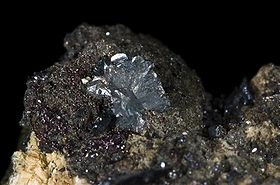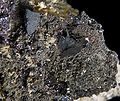- Stéphanite (minéral)
-
Stephanite
Catégorie II : sulfures et sulfosels[1]
Stéphanite et pyrargirite - Grube Gnade Gottes, St Andreasberg, Allemagne (xx 2 mm) Général Classe de Strunz 2.GB.10 Formule brute Ag5 SbS4 Identification Masse formulaire[2] 789,361 ± 0,022 uma
Ag 68,33 %, S 16,25 %, Sb 15,43 %,Couleur Gris de plomb à noir Classe cristalline et groupe d'espace Pyramidal - C mc21 Système cristallin Orthorhombique Réseau de Bravais Centré C Macle sur {110} moins commun sur {130}{100}{010} Clivage Imparfaite sur [010] pauvre sur [021] Cassure sub-conchoïdale Habitus Massif, cristaux tabulaires {001} Échelle de Mohs 2 à 2.5 Trait noir brillant Éclat métallique mat Propriétés optiques Fluorescence ultraviolet aucune Transparence opaque Propriétés chimiques Densité 6.25 Propriétés physiques Magnétisme aucun Radioactivité aucune Unités du SI & CNTP, sauf indication contraire. La stéphanite est une espèce minérale composée de sulfosel d’argent de formule Ag5 SbS4 avec des traces de As, Cu,Fe.
Sommaire
Historique de la description et appellations
Inventeur et étymologie
Décrit par Wilhelm Karl Ritter von Haidinger en 1845. Dédié à l'archiduc Stéphane d'Autriche (Étienne de Habsbourg-Lorraine, 1817-1867), ancien directeur des mines. Les cristaux peuvent atteindre 6 cm [3].
Topotype
Freiberg, Erzgebirge, en Saxe, Allemagne
Synonymie
- argent fragile,
- argent noir,
- argent sulfuré fragile Terme commun avec la pyrargyrite.
- psaturose François Sulpice Beudant (1832)
Caractéristiques physico-chimiques
Cristallographie
- Paramètres de la maille conventionnelle : a = 7,793 Å, b = 12,295 Å, c = 8,506 Å, Z = 4; V = 815,00 Å3
- Densité calculée = 6.43
Gîtes et gisements
Gîtologie et minéraux associés
- Gîtologie
- Dans les veines hydrothermales des dépôts d’argent.
- Minéraux associés
- proustite, acanthite, argent natif, tétraédrite, galène, sphalérite, pyrite
Gisements producteurs de spécimens remarquables
- Allemagne
-
- Neue Hoffnung Gottes Mine, Freiberg, Erzgebirge, en Saxe[4]
- Grube Gnade Gottes, St Andreasberg, Revier St Andreasberg, Harz, Basse Saxe[5]
- Canada
- France
- Mexique
Exploitation des gisements
- Utilisations
- Minerais d'argent.
Galerie
-
Pyrargyrite, Ankérite et stéphanite - Saxe Allemagne (Vue 1.5 cm)
Notes et références
- La classification des minéraux choisie est celle de Strunz.
- Masse molaire calculée d’après Atomic weights of the elements 2007 sur www.chem.qmul.ac.uk
- (en) John W. Anthony, Richard A. Bideaux, Kenneth W. Bladh et Monte C. Nichols, The Handbook of Mineralogy : Elements, Sulfides, Sulfosalts, vol. I, Mineral Data Publishing, 1990
- Hofmann, F. (1986): Die Freiberger Mineralien. Lapis 11(7/8), 28-55.
- Weiss: "Mineralfundstellen, Deutschland West", Weise (Munich), 1990
- Rocks & Min.:64:489.
- De Ascencao Guedes, R. (2003). "Les minéraux et les minéralogistes de Chessy-les-Mines." Le Règne Minéral, Hors Série(9), 46-85
- Mari, G. (2002). "La mine de Fontsante." Le Règne Minéral(43),pp:38-60
- Vialaron Ch. (1999) La mine d'antimoine de Daü, 127p, Le-Puy-en-Velay
- Terry Wallace (2008) Famous Mineral Localities: The Las Chispas Mine, Arizpe, Sonora, Mexico. Mineralogical Record 39:6 pp41-50
- Portail des minéraux et roches
- Portail de la chimie
Wikimedia Foundation. 2010.



